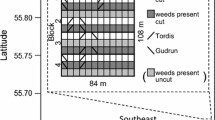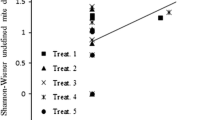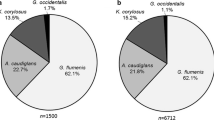Abstract
Habitat management such as ground cover implementation in orchards is considered a promising approach to augment natural enemy abundance and diversity. However, the actual effects of grass cover management and specifically mowing frequency, on the abundance of tree natural enemies and thus on the biocontrol of major pests, are still largely unknown. We compared the effect of three heights, tall (no cutting), medium (mean height of 20 cm) and short (mean height of 5 cm), of a spontaneous grass cover in an experimental orchard on natural enemy abundance and predation rates from April to August. Early in the season (from April to May) grass cover height had no effect on codling moth egg predation. However later in the season (July and August) the predation rate increased more in the short grass cover than in the tall grass (66 vs. 38 %. respectively). The abundance of the earwig Forficula pubescens (Gené) (Dermaptera: Forficulidae) was significantly positively correlated with egg predation in the plots with short grass but negatively correlated in the tall and medium plots suggesting that these predators could find an alternative resource in the taller grass cover.

Similar content being viewed by others
References
Atanassov A, Shearer PW, Hamilton GC (2003) Peach pest management programs impact beneficial fauna abundance and Grapholita molesta (Lepidoptera: Tortricidae) egg parasitism and predation. Environ Entomol 32:780–788
Barton K (2013) Package “MuMin”. Version 1.9.18. Available on: http://cran.r-project.org/web/packages/MuMIn/MuMIn.pdf. Cited 2 April 2014
Bates D, Maechler M, Bolker B, Walker S, RHB. C, Singmann H (2014) Package lme4: linear mixed-effects models using eigen and S4. Available on : http://cran.r-project.org/web/packages/lme4/lme4.pdf. Cited 2 April 2014
Bogya S, Marko V, Szinetar C (2000) Effect of pest management systems on foliage- and grass-dwelling spider communities in an apple orchard in Hungary. Int J Pest Manag 46:241–250
Burnip G, Daly J, Hackett J, Suckling D (2002) European earwig phenology and effect of understorey management on population estimation. NZ Plant Prot 55:390–395
Chang GC, Snyder WE (2004) The relationship between predator density, community composition, and field predation of Colorado potato beetle eggs. Biol Control 31:453–461
Debras JF (2007) Rôles fonctionnels des haies dans la régulation des ravageurs: le cas du psylle Cacopsylla pyri L. dans les vergers du sud-est de la France. These Université d’Avignon et des pays de Vaucluse
Development Core Team R (2010) R: a language and environment for statistical computing. R Foundation for Statistical Computing, Vienna
Dib H, Simon S, Sauphanor B, Capowiez Y (2010) The role of natural enemies on the population dynamics of the rosy apple aphid, Dysaphis plantaginea Passerini (Hemiptera: Aphididae) in organic apple orchards in south-eastern France. Biol Control 55:97–109
Evans EW (2009) Lady beetles as predators of insects other than Hemiptera. Biol Control 51:255–267
Finke DL, Snyder WE (2010) Conserving the benefits of predator biodiversity. Biol Conserv 143:2260–2269
Glen DM (1977) Predation of codling moth eggs, Cydia pomonella, predators responsible and their alternative prey. J Appl Ecol 14:445–456
Helsen H, Vaal F, Blommers L (1998) Phenology of the common earwig Forficula auricularia L. (Dermaptera: Forficulidae) in an apple orchard. Int J Pest Manag 44:75–79
Hogg BN, Daane KM (2011) Diversity and invasion within a predator community: impacts on herbivore suppression. J Appl Ecol 48:453–461
Horton DR, Broers DA, Lewis RR, Granatstein D, Zack RS, Unruh TR, Moldenke AR, Brown JJ (2003) Effects of mowing frequency on densities of natural enemies in three Pacific Northwest pear orchards. Entomol Exp Appl 106:135–145
Horton DR, Jones VP, Unruh TR (2009) Use of a new immunomarking method to assess movement by generalist predators between a cover crop and tree canopy in a pear orchard. Am Entomol 55:49–56
Kruess A, Tscharntke T (2002) Contrasting responses of plant and insect diversity to variation in grazing intensity. Biol Conserv 106:293–302
Landis DA, Wratten SD, Gurr GM (2000) Habitat management to conserve natural enemies of arthropod pests in agriculture. Annu Rev Entomol 45:175–201
Langellotto G, Denno R (2004) Responses of invertebrate natural enemies to complex-structured habitats: a meta-analytical synthesis. Oecologia 139:1–10
Lawton J (1983) Plant architecture and the diversity of phytophagous insects. Annu Rev Entomol 28:23–39
Letourneau DK, Jedlicka JA, Bothwell SG, Moreno CR (2009) Effects of natural enemy biodiversity on the suppression of arthropod herbivores in terrestrial ecosystems. Annu Rev Ecol Evol Syst 40:573–592
Markó V, Keresztes B (2014) Flowers for better pest control? Ground cover plants enhance apple orchard spiders (Araneae), but not necessarily their impact on pests. Biocontrol Sci Technol 24:574–596
Monteiro LB, Lavigne C, Ricci B, Franck P, Toubon J-F, Sauphanor B (2013) Predation of codling moth eggs is affected by pest management practices at orchard and landscape levels. Agric Ecosyst Environ 166:86–93
Pearce S, Hebron WM, Raven RJ, Zalucki MP, Hassan E (2004) Spider fauna of soybean crops in south-east Queensland and their potential as predators of Helicoverpa spp. (Lepidoptera: Noctuidae). Aust J Entomol 43:57–65
Pekar S (1999) Effect of IPM pratices and conventional spraying on spider population dynamics in an apple orchard. Agr Ecosyst Environ 26:155–166
Rieux R, Simon S, Defrance H (1999) Role of hedgerows and ground cover management on arthropod populations in pear orchards. Agric Ecosyst Environ 73:119–127
Robinson KA, Jonsson M, Wratten SD, Wade MR, Buckley HL (2008) Implications of floral resources for predation by an omnivorous lacewing. Basic Appl Ecol 9:172–181
Romeu-Dalmau C, Espadaler X, Pinol J (2012) Abundance, interannual variation and potential pest predator role of two co-occurring earwig species in citrus canopies. J Appl Entomol 136:501–509
Sauphanor B, Sureau F (1993) Aggregation behavior and interspecific relationships in Dermaptera. Oecologia 96:360–364
Sauphanor B, Dirwimmer C, Boutin S, Chaussabel A, Dupont N, Fauriel J, Gallia V, Lambert N, Navarro E, Parisi L, Plenet D, Ricaud V, Sagnes J, Sauvaitre D, Simon S, Speich P, Zavagli F (2009) Analyse comparative de différents systèmes en arboriculture fruitière. In: INRA (ed) Ecophyto R&D: vers des systèmes de culture économes en produits phytosanitaires. Rapport d’Expertise Collective Inra, Tome IV, p 49
Schellhorn NA, Bianchi F, Hsu CL (2014) Movement of entomophagous arthropods in agricultural landscapes: links to pest suppression. Annu Rev Entomol 59:559–581
Silva EB, Franco JC, Vasconcelos T, Branco M (2010) Effect of ground cover vegetation on the abundance and diversity of beneficial arthropods in citrus orchards. Bull Entomol Res 100:489–499
Simon S, Defrance H, Sauphanor B (2007) Effect of codling moth management on orchard arthropods. Agric Ecosyst Environ 122:340–348
Simon S, Bouvier J-C, Debras J-F, Sauphanor B (2010) Biodiversity and pest management in orchard systems. A review. Agron Sustain Dev 30:139–152
Simon S, Brun L, Guinaudeau J, Sauphanor B (2011) Pesticide use in current and innovative apple orchard systems. Agron Sustain Dev 31:541–555
Smith MW, Arnold DC, Eikenbary RD, Rice NR, Shiferaw A, Cheary BS, Carroll BL (1996) Influence of ground cover on beneficial arthropods in pecan. Biol Control 6:164–176
Straub CS, Finke DL, Snyder WE (2008) Are the conservation of natural enemy biodiversity and biological control compatible goals? Biol Control 45:225–237
Symondson WOC, Sunderland KD, Greenstone MH (2002) Can generalist predators be effective biocontrol agents? Annu Rev Entomol 47:561–594
Wan N-F, Ji X-Y, Gu X-J, Jiang J-X, Wu J-H, Li B (2014) Ecological engineering of ground cover vegetation promotes biocontrol services in peach orchards. Ecol Eng 64:62–65
Zuur AF, Leno EN, Walker NJ, Saveliev AA, Smith GM (2009) Mixed effects models and extensions in ecology with R. Springer, New York
Acknowledgments
The authors are grateful to Sandrine Maugin for providing codling moth eggs and Lachaize-Muller Amaya for assistance in the field and lab. The research project received funding from the European Union Seventh Framework Programme (FP7/2007–2013) under the grant agreement n°265865. The PhD fellowship of the first author was jointly financed by the ANR DynRurABio program and the INRA Smach metaprogram.
Author information
Authors and Affiliations
Corresponding author
Additional information
Handling Editor: Dirk Babendreier.
Rights and permissions
About this article
Cite this article
Marliac, G., Simon, S., Mazzia, C. et al. Increased grass cover height in the alleys of apple orchards does not promote Cydia pomonella biocontrol. BioControl 60, 805–815 (2015). https://doi.org/10.1007/s10526-015-9687-y
Received:
Accepted:
Published:
Issue Date:
DOI: https://doi.org/10.1007/s10526-015-9687-y




